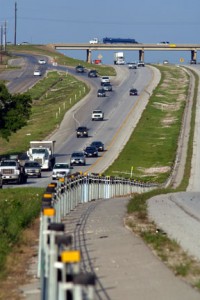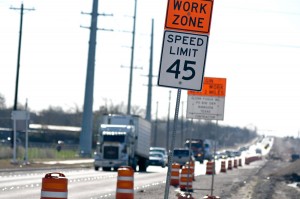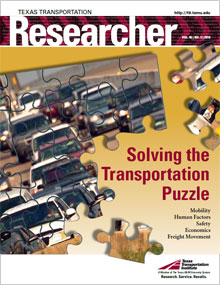
It’s five times safer to travel on our nation’s roadways today than it was five decades ago. For every 100 million miles Americans traveled in 1960, five people died. Today, the rate has dropped to just over one death per 100 million miles.
“As a nation 50 years ago, we decided that killing tens of thousands of people a year was unacceptable,” says Roger Bligh, manager of Texas Transportation Institute’s (TTI) Roadside Safety Program. “That’s why the concept of the ‘forgiving roadside’ was developed.”
In the 1960s, TTI led the safety movement on the new Interstate Highway System by conducting crash tests on signs, guardrails and crash cushions at its Proving Ground Research Facility, the Institute’s crown jewel for improving roadside safety.
TTI‘s technological innovations can now be seen on virtually every mile of roadway in Texas. Since TTI researchers created the earliest versions of the slip-base breakaway signs in the 1960s, more than 2,000 crash tests have been conducted at the Proving Ground, which recently gained accreditation by the American Association for Laboratory Accreditation* for “technical competence in the field of mechanical testing.” Today, the facility also includes the Center for Transportation Computational Mechanics, where analysts run computer simulations to evaluate potential roadside safety solutions before performing the actual crash.
Perhaps TTI‘s most recognizable contribution to the forgiving roadside is the ET2000® guardrail end treatment. Developed in 1991, over half a million units have been installed throughout the United States and around the world. The ET2000® absorbs energy from a crash by deflecting the guardrail away from the impacting vehicle.
Recently, TTI helped develop and crash-test more forgiving median barriers made of cables rather than concrete. Concrete barriers continue to serve an important role in separating traffic on urban highways with narrow medians, but cable barriers have proven very cost effective in reducing head-on collisions across traffic lanes while slowing down vehicles with minimal impact on their occupants. The result has been a dramatic decrease in cross-median collision fatalities where cable median barriers have been implemented in the United States.
“Passenger vehicles can hit the cable, and most of the time they just drive off,” explains Marla Jasek, director of transportation operations for the Texas Department of Transportation Yoakum District.
But the forgiving roadside doesn’t maintain itself. Crews work to improve and repair roadways while drivers speed by, creating danger for both workers and drivers. An estimated 1,000 people are killed and 45,000 are injured in United States roadway work zones each year.
Portable concrete barriers are an integral part of the work-zone safety equation, shielding motorists and protecting workers. TTI continues to develop new barrier alternatives that offer designers safe and effective solutions for restricted work-zone sites. The new X-bolt connection reduces the deflection of free-standing barriers to less than 2 feet, and a drop-pin anchorage system permits portable concrete barriers to be installed along the edge of a bridge deck.

TTI is also promoting work-zone safety through its award-winning National Work Zone Safety Information Clearinghouse (http://www.workzonesafety.org), the world’s largest Internet resource on all things related to work-zone safety. The clearinghouse is a project of the American Road and Transportation Builders Association and is operated in cooperation with the U.S. Federal Highway Administration and TTI. Since the site went online in 1998, it has assisted half a million users from every state and 27 countries with a variety of topics related to safety issues in work zones.
“We have all come together to make a real difference in making work zones safer,” says Jerry Ullman, manager of TTI‘s Work Zone and Dynamic Message Signs Program.
Commentary on Safety
by Mary McDonough
Roadway Departure Program Manager
Federal Highway Administration
“Roadway departure” refers to vehicles crossing a center or edge line or otherwise leaving a roadway. Crashes from roadway departure account for over half of U.S. fatalities. Causes of leaving the roadway include use of alcohol and cell phones, speeding and distracted driving. Some die from these crashes. Many more suffer incapacitating, lifelong injuries. They and those who know them are profoundly changed by these events.
What most people don’t realize is that the deadliest place to drive isn’t a busy freeway or a high-speed interstate. It’s a two-lane rural road. Horizontal curves, pavement drop-offs, narrow lanes, and trees and poles next to the roadway — all pose serious dangers on these roads.
Roadside safety countermeasures have dramatically improved in recent decades. Guardrail end treatments, breakaway signs, cable median barriers and other technological innovations keep millions safe when they depart the roadway. And more safety measures to reduce crashes and their severity are being developed.
The Federal Highway Administration’s policy and guidance includes performance testing for roadside hardware devices before they’re installed. Formal acceptance of crashworthy devices is our responsibility, and external partners with the highest standards of quality, such as the researchers at the Texas Transportation Institute (TTI) Proving Ground, greatly assist us in that mission. TTI has helped raise the bar of excellence for other researchers. The Institute’s consistently reliable, proactive approach to device testing has helped save thousands of lives, not only in Texas but across the nation.
Our greatest hope is that you never use the safety features installed on roadways. No matter how well we do our jobs, the best way to avoid injury is for you, the individual, to be a consciously competent driver (and passenger). So stay safe, stay alert, and be cautious, especially on two-lane roads. Ultimately, safety is the responsibility of each and every one of us.
* Not included in the original article: The TTI Proving Ground is an International Standards Organization (ISO) 17025 accredited laboratory with American Association for Laboratory Accreditation (A2LA) Mechanical Testing Certificate No. 2821.01.
